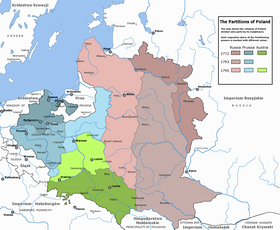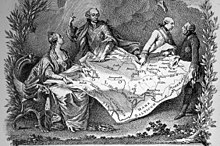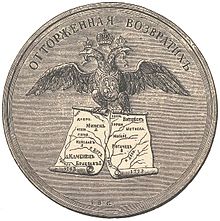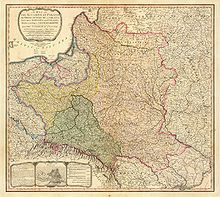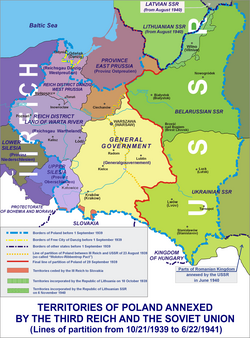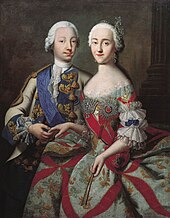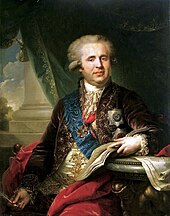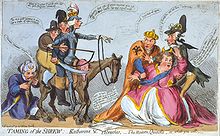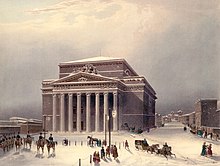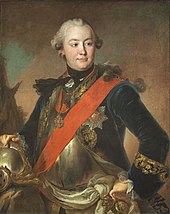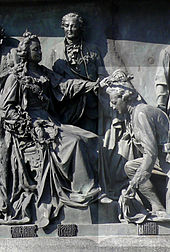From Wikipedia, the free encyclopedia
Catherine II (born Sophie of Anhalt-Zerbst; 2 May 1729 – 17 November 1796), most commonly known as Catherine the Great, was the reigning empress of Russia from 1762 to 1796. She came to power following the overthrow of her husband, Peter III. Under her long reign, inspired by the ideas of the Enlightenment,
Russia experienced a renaissance of culture and sciences, which led to
the founding of many new cities, universities, and theatres; along with
large-scale immigration from the rest of Europe, and the recognition of
Russia as one of the great powers of Europe.
In her accession to power and her rule of the empire, Catherine often relied on her noble favourites, most notably Count Grigory Orlov and Grigory Potemkin. Assisted by highly successful generals such as Alexander Suvorov and Pyotr Rumyantsev, and admirals such as Samuel Greig and Fyodor Ushakov, she governed at a time when the Russian Empire was expanding rapidly by conquest and diplomacy. In the south, the Crimean Khanate was crushed following victories over the Bar Confederation and Ottoman Empire in the Russo-Turkish War. With the support of Great Britain, Russia colonised the territories of New Russia along the coasts of the Black and Azov Seas. In the west, the Polish–Lithuanian Commonwealth, ruled by Catherine's former lover King Stanisław August Poniatowski, was eventually partitioned, with the Russian Empire gaining the largest share. In the east, Russians became the first Europeans to colonise Alaska, establishing Russian America.
Many cities and towns were founded on Catherine's orders in the newly conquered lands, most notably Odessa, Yekaterinoslav (to-day known as Dnipro), Kherson, Nikolayev, and Sevastopol. An admirer of Peter the Great,
Catherine continued to modernise Russia along Western European lines.
However, military conscription and the economy continued to depend on serfdom,
and the increasing demands of the state and of private landowners
intensified the exploitation of serf labour. This was one of the chief
reasons behind rebellions, including Pugachev's Rebellion of Cossacks, nomads, peoples of the Volga, and peasants.
The period of Catherine the Great's rule is also known as the Catherinian Era. The Manifesto on Freedom of the Nobility,
issued during the short reign of Peter III and confirmed by Catherine,
freed Russian nobles from compulsory military or state service.
Construction of many mansions of the nobility, in the classical style endorsed by the empress, changed the face of the country. She is often included in the ranks of the enlightened despots. As a patron of the arts, she presided over the age of the Russian Enlightenment, including the establishment of the Smolny Institute of Noble Maidens, the first state-financed higher education institution for women in Europe.
Early life
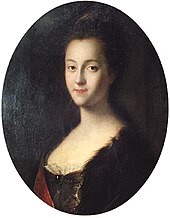
Catherine was born in Stettin, Province of Pomerania, Kingdom of Prussia, Holy Roman Empire, as Princess Sophie Friederike Auguste von Anhalt-Zerbst-Dornburg. Her mother was Joanna Elisabeth of Holstein-Gottorp. Her father, Christian August, Prince of Anhalt-Zerbst, belonged to the ruling German family of Anhalt. He failed to become the duke of Duchy of Courland and Semigallia
and at the time of his daughter's birth held the rank of a Prussian
general in his capacity as governor of the city of Stettin. However,
because her second cousin Peter III converted to Orthodox Christianity,
her mother's brother became the heir to the Swedish throne and two of her first cousins, Gustav III and Charles XIII, later became Kings of Sweden.
In accordance with the custom then prevailing in the ruling dynasties
of Germany, she received her education chiefly from a French governess
and from tutors. According to her memoirs, Sophie was regarded as a tomboy, and trained herself to master a sword.
Sophie's childhood was very uneventful. She once wrote to her correspondent Baron Grimm: "I see nothing of interest in it."
Although Sophie was born a princess, her family had very little money.
Her rise to power was supported by her mother Joanna's wealthy
relatives, who were both nobles and royal relations.
The more than 300 sovereign entities of the Holy Roman Empire, many of
them quite small and powerless, made for a highly competitive political
system as the various princely families fought for advantage over each
other, often via political marriages.
For the smaller German princely families, an advantageous marriage was
one of the best means of advancing their interests, and the young Sophie
was groomed throughout her childhood to be the wife of some powerful
ruler in order to improve the position of the reigning house of Anhalt.
Besides her native German, Sophie became fluent in French, the lingua franca of European elites in the 18th century.
The young Sophie received the standard education for an 18th-century
German princess, with a concentration upon learning the etiquette
expected of a lady, French, and Lutheran theology.
Sophie first met her future husband, who would become Peter III of Russia,
at the age of 10. Peter was her second cousin. Based on her writings,
she found Peter detestable upon meeting him. She disliked his pale
complexion and his fondness for alcohol at such a young age. Peter also
still played with toy soldiers. She later wrote that she stayed at one
end of the castle, and Peter at the other.
Marriage and reign of Peter III
Portrait of the Grand Duchess Ekaterina Alekseyevna (the future Catherine the Great) around the time of her wedding, by
Georg Christoph Grooth, 1745
The choice of Princess Sophie as wife of the future tsar was one result of the Lopukhina affair in which Count Jean Armand de Lestocq and King Frederick the Great
of Prussia took an active part. The objective was to strengthen the
friendship between Prussia and Russia, to weaken the influence of Austria, and to overthrow the chancellor Alexey Bestuzhev-Ryumin, a known partisan of the Austrian alliance on whom Russian Empress Elizabeth relied. The diplomatic intrigue failed, largely due to the intervention of Sophie's mother, Joanna Elisabeth of Holstein-Gottorp.
Historical accounts portray Joanna as a cold, abusive woman who loved
gossip and court intrigues. Her hunger for fame centred on her
daughter's prospects of becoming empress of Russia, but she infuriated
Empress Elizabeth, who eventually banned her from the country for spying
for King Frederick. Empress Elizabeth knew the family well and had
intended to marry Princess Joanna's brother Charles Augustus (Karl August von Holstein); however, he died of smallpox in 1727 before the wedding could take place.
Despite Joanna's interference, Empress Elizabeth took a strong liking
to Sophie, and Sophie and Peter eventually married in 1745.
When Sophie arrived in Russia in 1744, she spared no effort to
ingratiate herself not only with Empress Elizabeth but with her husband
and with the Russian people as well. She applied herself to learning the
Russian language with zeal, rising at night and walking about her
bedroom barefoot, repeating her lessons. When she wrote her memoirs, she
said she made the decision then to do whatever was necessary and to
profess to believe whatever was required of her to become qualified to
wear the crown. Although she mastered the language, she retained an
accent.
Equestrian portrait of Grand Duchess Ekaterina Alekseyevna
Sophie recalled in her memoirs that as soon as she arrived in Russia, she fell ill with a pleuritis that almost killed her. She credited her survival to frequent bloodletting; in a single day, she had four phlebotomies.
Her mother's opposition to this practice brought her the empress's
disfavour. When Sophie's situation looked desperate, her mother wanted
her confessed by a Lutheran pastor. Awaking from her delirium, however,
Sophie said, "I don't want any Lutheran; I want my Orthodox father
[clergyman]". This raised her in the empress's esteem.
Princess Sophie's father, a devout German Lutheran, opposed his daughter's conversion to Eastern Orthodoxy. Despite his objections, on 28 June 1744, the Russian Orthodox Church received Princess Sophie as a member with the new name Catherine (Yekaterina or Ekaterina) and the (artificial) patronymic Алексеевна (Alekseyevna, daughter of Aleksey), so that she was in all respects the namesake of Catherine I,
the mother of Elizabeth and the grandmother of Peter III. On the
following day, the formal betrothal of Catherine and Peter took place
and the long-planned dynastic marriage finally occurred on 21 August
1745 in Saint Petersburg.
Sophie had turned 16. Her father did not travel to Russia for the
wedding. The bridegroom, known as Peter von Holstein-Gottorp, had become
Duke of Holstein-Gottorp (located in the north-west of present-day Germany near the border with Denmark) in 1739. The newlyweds settled in the palace of Oranienbaum,
which remained the residence of the "young court" for many years. From
there, they governed the duchy (which occupied less than a third of the
current German state of Schleswig-Holstein, even including that part of
Schleswig occupied by Denmark) to obtain experience to govern Russia.
Apart from providing that experience, the marriage was
unsuccessful—it was not consummated for years due to Peter III's mental
immaturity. After Peter took a mistress, Catherine became involved with
other prominent court figures. She soon became popular with several
powerful political groups that opposed her husband. Bored with her
husband, Catherine became an avid reader of books, mostly in French.
She disparaged her husband for his devotion to reading on the one hand
"Lutheran prayer-books, the other the history of and trial of some
highway robbers who had been hanged or broken on the wheel". It was during this period that she first read Voltaire and the other philosophes of the French Enlightenment. As she learned Russian, she became increasingly interested in the literature of her adopted country. Finally, it was the Annals by Tacitus
that caused what she called a "revolution" in her teenage mind as
Tacitus was the first intellectual she read who understood power
politics as they are, not as they should be. She was especially
impressed with his argument that people do not act for their professed
idealistic reasons, and instead she learned to look for the "hidden and
interested motives".
According to Alexander Hertzen, who edited a version of Catherine's memoirs, Catherine had her first sexual relationship with Sergei Saltykov while living at Oranienbaum as her marriage to Peter had not been consummated, as Catherine later claimed.
Catherine nonetheless left the final version of her memoirs to Paul I
in which she explained why Paul had been Peter's son. Sergei Saltykov
was used to make Peter jealous, and relations with Saltykov were
platonic. Catherine wanted to become an empress herself and did not want
another heir to the throne; however, Empress Elizabeth blackmailed
Peter and Catherine to produce this heir. Peter and Catherine had both
been involved in a 1749 Russian military plot to crown Peter (together
with Catherine) in Elizabeth's stead. As a result of this plot,
Elizabeth likely wanted to leave both Catherine and her accomplice Peter
without any rights to the Russian throne. Elizabeth therefore allowed
Catherine to have sexual lovers only after a new legal heir, Catherine
and Peter's son, survived and appeared to be strong.
After this, Catherine carried on sexual liaisons over the years with many men, including Stanislaus Augustus Poniatowski, Grigory Grigoryevich Orlov (1734–1783), Alexander Vasilchikov, Grigory Potemkin, Ivan Rimsky-Korsakov, and others. She became friends with Princess Ekaterina Vorontsova-Dashkova,
the sister of her husband's official mistress. In Dashkov's opinion,
Dashkov introduced Catherine to several powerful political groups that
opposed her husband; however, Catherine had been involved in military
schemes against Elizabeth with the likely goal of subsequently getting
rid of Peter III since at least 1749.
Peter III's temperament became quite unbearable for those who
resided in the palace. He would announce trying drills in the morning to
male servants, who later joined Catherine in her room to sing and dance
until late hours.
In 1759, Catherine became pregnant with her second child, Anna,
who only lived to 14 months. Due to various rumours of Catherine's
promiscuity, Peter was led to believe he was not the child's biological
father and is known to have proclaimed, "Go to the devil!" when
Catherine angrily dismissed his accusation. She thus spent much of this
time alone in her private boudoir to hide away from Peter's abrasive personality.
In the first version of her memoirs, edited and published by Alexander
Hertzen, Catherine strongly implied that the real father of her son Paul
was not Peter, but rather Saltykov.
Catherine recalled in her memoirs her optimistic and resolute mood before her accession to the throne:
I used to say to myself that happiness and misery depend
on ourselves. If you feel unhappy, raise yourself above unhappiness, and
so act that your happiness may be independent of all eventualities.
Tsar
Peter III and his wife, the future Catherine the Great. He reigned only six months, and died on 17 July 1762.
After the death of the Empress Elizabeth on 5 January 1762 (OS: 25 December 1761), Peter succeeded to the throne as Emperor Peter III, and Catherine became empress consort. The imperial couple moved into the new Winter Palace
in Saint Petersburg. The emperor's eccentricities and policies,
including a great admiration for the Prussian king Frederick II,
alienated the same groups that Catherine had cultivated. Russia and
Prussia had fought each other during the Seven Years' War
(1756–1763), and Russian troops had occupied Berlin in 1761. Peter,
however, supported Frederick II, eroding much of his support among the
nobility. Peter ceased Russian operations against Prussia, and Frederick
suggested the partition of Polish territories with Russia. Peter also intervened in a dispute between his Duchy of Holstein and Denmark over the province of Schleswig (see Count Johann Hartwig Ernst von Bernstorff). As Duke of Holstein-Gottorp, Peter planned war against Denmark, Russia's traditional ally against Sweden.
In July 1762, barely six months after becoming emperor, Peter
lingered in Oranienbaum with his Holstein-born courtiers and relatives,
while his wife lived in another palace nearby. On the night of 8 July
(OS: 27 June 1762),
Catherine was given the news that one of her co-conspirators had been
arrested by her estranged husband and that all they had been planning
must take place at once. The next day, she left the palace and departed
for the Ismailovsky Regiment,
where she delivered a speech asking the soldiers to protect her from
her husband. Catherine then left with the Ismailovsky Regiment to go to
the Semenovsky Barracks, where the clergy was waiting to ordain her as
the sole occupant of the Russian throne. She had her husband arrested,
and forced him to sign a document of abdication, leaving no one to
dispute her accession to the throne. On 17 July 1762—eight days after the coup that amazed the outside world and just six months after his accession to the throne—Peter III died at Ropsha, possibly at the hands of Alexei Orlov
(younger brother to Grigory Orlov, then a court favourite and a
participant in the coup). Peter supposedly was assassinated, but it is
unknown how he died. The official cause, after an autopsy, was a severe
attack of haemorrhoidal colic and an apoplexy stroke.
At the time of Peter III's overthrow, other potential rivals for the throne included Ivan VI (1740–1764), who had been confined at Schlüsselburg in Lake Ladoga
from the age of six months and who was thought to be insane. Ivan VI
was assassinated during an attempt to free him as part of a failed coup.
Like Empress Elizabeth before her, Catherine had given strict
instructions that Ivan was to be killed in the event of any such
attempt. Yelizaveta Alekseyevna Tarakanova (1753–1775) was another potential rival.
Although Catherine did not descend from the Romanov dynasty, her ancestors included members of the Rurik dynasty, which preceded the Romanovs. She succeeded her husband as empress regnant, following the precedent established when Catherine I succeeded her husband Peter the Great in 1725. Historians debate Catherine's technical status, whether as a regent or as a usurper, tolerable only during the minority of her son, Grand Duke Paul.
Reign (1762–1796)
Coronation (1762)
Catherine II on a balcony of the Winter Palace on 9 July [
O.S. 28 June] 1762, the day of the coup
Catherine was crowned at the Assumption Cathedral in Moscow on 22 September 1762. Her coronation marks the creation of one of the main treasures of the Romanov dynasty, the Imperial Crown of Russia, designed by Swiss-French court diamond jeweller Jérémie Pauzié. Inspired by Byzantine
design, the crown was constructed of two half spheres, one gold and one
silver, representing the eastern and western Roman empires, divided by a
foliate garland and fastened with a low hoop. The crown contains 75
pearls and 4,936 Indian diamonds forming laurel and oak leaves, the
symbols of power and strength, and is surmounted by a 398.62-carat ruby
spinel that previously belonged to the Empress Elizabeth, and a diamond
cross. The crown was produced in a record two months and weighed 2.3 kg
(5.1 lbs).
From 1762, the Great Imperial Crown was the coronation crown of all
Romanov emperors until the monarchy's abolition in 1917. It is one of
the main treasures of the Romanov dynasty and is now on display in the
Moscow Kremlin Armoury Museum.
Foreign affairs
During her reign, Catherine extended the borders of the Russian Empire by some 520,000 square kilometres (200,000 sq mi), absorbing New Russia, Crimea, the North Caucasus, right-bank Ukraine, White Russia, Lithuania, and Courland at the expense, mainly, of two powers—the Ottoman Empire and the Polish–Lithuanian Commonwealth.
Catherine's foreign minister, Nikita Panin
(in office 1763–1781), exercised considerable influence from the
beginning of her reign. A shrewd statesman, Panin dedicated much effort
and millions of roubles to setting up a "Northern Accord" between
Russia, Prussia, Poland and Sweden, to counter the power of the Bourbon–Habsburg League. When it became apparent that his plan could not succeed, Panin fell out of favour and Catherine had him replaced with Ivan Osterman (in office 1781–1797).
Catherine agreed to a commercial treaty
with Great Britain in 1766, but stopped short of a full military
alliance. Although she could see the benefits of Britain's friendship,
she was wary of Britain's increased power following its complete victory
in the Seven Years' War, which threatened the European balance of power.
Russo-Turkish Wars
Peter the Great had succeeded in gaining a toehold in the south, on the edge of the Black Sea, in the Azov campaigns. Catherine completed the conquest of the south, making Russia the dominant power in the Balkans after the Russo-Turkish War of 1768–1774. Russia inflicted some of the heaviest defeats ever suffered by the Ottoman Empire, including the Battle of Chesma (5–7 July 1770) and the Battle of Kagul (21 July 1770). In 1769, a last major Crimean–Nogai slave raid, which ravaged the Russian held territories in Ukraine, saw the capture of up to 20,000 slaves.
The Russian victories procured access to the Black Sea and
allowed Catherine's government to incorporate present-day southern
Ukraine, where the Russians founded the new cities of Odessa, Nikolayev, Yekaterinoslav (literally: "the Glory of Catherine"), and Kherson. The Treaty of Küçük Kaynarca, signed 10 July 1774, gave the Russians territories at Azov, Kerch, Yenikale, Kinburn, and the small strip of Black Sea coast between the rivers Dnieper and Bug.
The treaty also removed restrictions on Russian naval or commercial
traffic in the Azov Sea, granted to Russia the position of protector of Orthodox Christians
in the Ottoman Empire, and made the Crimea a protectorate of Russia.
Russia's State Council in 1770 announced a policy in favour of eventual
Crimean independence. Catherine named Şahin Giray,
a Crimean Tatar leader, to head the Crimean state and maintain friendly
relations with Russia. His period of rule proved disappointing after
repeated effort to prop up his regime through military force and
monetary aid. Finally Catherine annexed the Crimea in 1783. The palace of the Crimean Khanate
passed into the hands of the Russians. In 1787, Catherine conducted a
triumphal procession in the Crimea, which helped provoke the next
Russo-Turkish War.
Catherine extended the borders of the Russian Empire southward to absorb the
Crimean KhanateThe Ottomans restarted hostilities in the Russo-Turkish War of 1787–1792. This war was another catastrophe for the Ottomans, ending with the Treaty of Jassy (1792), which legitimised the Russian claim to the Crimea and granted the Yedisan region to Russia.
Russo-Persian War
In the Treaty of Georgievsk (1783), Russia agreed to protect Georgia against any new invasion and further political aspirations of their Persian suzerains. Catherine waged a new war against Persia in 1796 after they, under the new king Agha Mohammad Khan, had again invaded Georgia
and established rule in 1795 and had expelled the newly established
Russian garrisons in the Caucasus. The ultimate goal for the Russian
government, however, was to topple the anti-Russian shah (king), and to
replace him with a half-brother, Morteza Qoli Khan, who had defected to Russia and was therefore pro-Russian.
It was widely expected that a 13,000-strong Russian corps would be led by the seasoned general, Ivan Gudovich, but the empress followed the advice of her lover, Prince Zubov, and entrusted the command to his youthful brother, Count Valerian Zubov. The Russian troops set out from Kizlyar in April 1796 and stormed the key fortress of Derbent on 10 May. The event was glorified by the court poet Derzhavin in his famous ode; he later commented bitterly on Zubov's inglorious return from the expedition in another remarkable poem.
By mid-June 1796, Zubov's troops overran without any resistance most of the territory of modern-day Azerbaijan, including three principal cities—Baku, Shemakha, and Ganja. By November, they were stationed at the confluence of the Araks and Kura Rivers,
poised to attack mainland Iran. In this month, the empress of Russia
died and her successor Paul, who detested that the Zubovs had other
plans for the army, ordered the troops to retreat to Russia. This
reversal aroused the frustration and enmity of the powerful Zubovs and
other officers who took part in the campaign: many of them would be
among the conspirators who arranged Paul's murder five years later.
Relations with Western Europe
Catherine longed for recognition as an enlightened sovereign. She
refused the Duchy of Holstein-Gottorp which had ports on the coast of
the Atlantic Ocean, and refrained from having a Russian army in Germany.
Instead she pioneered for Russia the role that Britain later played
through most of the 19th and early 20th centuries as an international
mediator in disputes that could, or did, lead to war. She acted as
mediator in the War of the Bavarian Succession (1778–1779) between the German states of Prussia and Austria. In 1780, she established a League of Armed Neutrality, designed to defend neutral shipping from being searched by the British Royal Navy during the American Revolutionary War.
From 1788 to 1790, Russia fought a war against Sweden,
a conflict instigated by Catherine's cousin, King Gustav III of Sweden,
who expected to overrun the Russian armies still engaged in war against
the Ottoman Turks, and hoped to strike Saint Petersburg directly. But
Russia's Baltic Fleet checked the Royal Swedish navy in the tied Battle of Hogland (July 1788), and the Swedish army failed to advance. Denmark declared war on Sweden in 1788 (the Theatre War). After the decisive defeat of the Russian fleet at the Battle of Svensksund in 1790, the parties signed the Treaty of Värälä (14 August 1790), returning all conquered territories to their respective owners and confirming the Treaty of Åbo.
Russia was to stop any involvement in internal affairs of Sweden. Large
sums were paid to Gustav III. Peace ensued for 20 years in spite of the
assassination of Gustav III in 1792.
Partitions of Polish–Lithuanian Commonwealth
In 1764, Catherine placed Stanislaus Augustus Poniatowski, her former lover, on the Polish throne.
Although the idea of partitioning Poland came from the King Frederick
II of Prussia, Catherine took a leading role in carrying it out in the
1790s. In 1768, she formally became the protector of political rights of
dissidents and peasants of the Polish–Lithuanian Commonwealth, which
provoked an anti-Russian uprising in Poland, the Confederation of Bar
(1768–1772), supported by France. After the rebels, their French and
European volunteers, and their allied Ottoman Empire had been defeated,
she established in the Commonwealth a system of government fully
controlled by the Russian Empire through a Permanent Council, under the supervision of her ambassadors and envoys.
Being afraid of the May Constitution of Poland
(1791) that might lead to a resurgence in the power of the
Polish–Lithuanian Commonwealth and the growing democratic movements
inside the Commonwealth might become a threat to the European
monarchies, Catherine decided to refrain from her planned intervention
into France and to intervene in Poland instead. She provided support to a
Polish anti-reform group known as the Targowica Confederation. After defeating Polish loyalist forces in the Polish–Russian War of 1792 and in the Kościuszko Uprising
(1794), Russia completed the partitioning of Poland, dividing all of
the remaining Commonwealth territory with Prussia and Austria (1795).
Relations with China
The Qianlong Emperor
of China was committed to an expansionist policy in Central Asia and
saw the Russian Empire as a potential rival, making for difficult and
unfriendly relations between Beijing and Saint Petersburg. In 1762, he unilaterally abrogated the Treaty of Kyakhta, which governed the caravan trade between the two empires. Another source of tension was the wave of Dzungar Mongol fugitives from the Chinese state who took refuge with the Russians. The Dzungar genocide
which was committed by the Qing state had led many Dzungars to seek
sanctuary in the Russian Empire, and it was also one of the reasons for
the abrogation of the Treaty of Kyakhta. Catherine perceived that the
Qianlong Emperor was an unpleasant and arrogant neighbour, once saying:
"I shall not die until I have ejected the Turks from Europe, suppressed
the pride of China and established trade with India". In a 1790 letter to Baron de Grimm written in French, she called the Qianlong Emperor "mon voisin chinois aux petits yeux" ("my Chinese neighbour with small eyes").
Relations with Japan
In the Far East, Russians became active in fur trapping in Kamchatka and the Kuril Islands.
This spurred Russian interest in opening trade with Japan to the south
for supplies and food. In 1783, storms drove a Japanese sea captain, Daikokuya Kōdayū, ashore in the Aleutian Islands,
at that time Russian territory. Russian local authorities helped his
party, and the Russian government decided to use him as a trade envoy.
On 28 June 1791, Catherine granted Daikokuya an audience at Tsarskoye Selo. Subsequently, in 1792, the Russian government dispatched a trade mission to Japan, led by Adam Laxman. The Tokugawa shogunate received the mission, but negotiations failed.
The evaluation of foreign policy
Nicholas I, her grandson, evaluated the foreign policy of Catherine the Great as a dishonest one.
Catherine failed to reach any of the initial goals she had put forward.
Her foreign policy lacked a long-term strategy and from the very start
was characterised by a series of mistakes. She lost the large
territories of the Russian protectorate of the Commonwealth of Poland
and Lithuania and left its territories to Prussia and Austria. The
Commonwealth had become the Russian protectorate since the reign of
Peter I, but he did not intervene into the problem of political freedoms
of dissidents advocating for their religious freedoms only. Catherine
did turn Russia into a global great power not only a European one but
with quite a different reputation from what she initially had planned as
an honest policy. The global trade by Russian natural resources and
Russian grain provoked famines, starvation and fear of famines in
Russia. Her dynasty lost power because of this and of a war with Austria
and Germany, impossible without her foreign policy.
Economics and finance
A 5-kopeck coin bearing the monogram of Catherine the Great and the Imperial coat of arms, dated 1791
Russian economic development was well below the standards in western
Europe. Historian François Cruzet writes that Russia under Catherine:
had neither a free peasantry, nor a
significant middle class, nor legal norms hospitable to private
enterprise. Still, there was a start of industry, mainly textiles around
Moscow and ironworks in the Ural Mountains, with a labour force mainly
of serfs, bound to the works.
Catherine imposed a comprehensive system of state regulation of
merchants' activities. It was a failure because it narrowed and stifled
entrepreneurship and did not reward economic development. She had more success when she strongly encouraged the migration of the Volga Germans,
farmers from Germany who settled mostly in the Volga River Valley
region. They indeed helped modernise the sector that totally dominated
the Russian economy. They introduced numerous innovations regarding
wheat production and flour milling, tobacco culture, sheep raising, and
small-scale manufacturing.
In 1768, the Assignation Bank
was given the task of issuing the first government paper money. It
opened in Saint Petersburg and Moscow in 1769. Several bank branches
were afterwards established in other towns, called government towns.
Paper notes were issued upon payment of similar sums in copper money,
which were also refunded upon the presentation of those notes. The
emergence of these assignation roubles
was necessary due to large government spending on military needs, which
led to a shortage of silver in the treasury (transactions, especially
in foreign trade, were conducted almost exclusively in silver and gold
coins). Assignation roubles circulated on equal footing with the silver
rouble; a market exchange rate for these two currencies was ongoing. The
use of these notes continued until 1849.
Catherine paid a great deal of attention to financial reform, and
relied heavily on the advice of Prince A. A. Viazemski. She found that
piecemeal reform worked poorly because there was no overall view of a
comprehensive state budget. Money was needed for wars and necessitated
the junking the old financial institutions. A key principle was
responsibilities defined by function. It was instituted by the
Fundamental Law of 7 November 1775. Vaizemski's Office of State Revenue
took centralised control and by 1781, the government possessed its first
approximation of a state budget.
Government organisation
Catherine made public health a priority. She made use of the social theory ideas of German cameralism and French physiocracy,
as well as Russian precedents and experiments such as foundling homes.
She launched the Moscow Foundling Home and lying-in hospital, 1764, and
Paul's Hospital, 1763. She had the government collect and publish vital
statistics. In 1762 called on the army to upgrade its medical services.
She established a centralised medical administration charged with
initiating vigorous health policies. Catherine decided to have herself
inoculated against smallpox by Thomas Dimsdale,
a British doctor. While this was considered a controversial method at
the time, she succeeded. Her son Pavel later was inoculated as well.
Catherine then sought to have inoculations throughout her empire and
stated: "My objective was, through my example, to save from death the
multitude of my subjects who, not knowing the value of this technique,
and frightened of it, were left in danger".
By 1800, approximately 2 million inoculations (almost 6% of the
population) were administered in the Russian Empire. Historians consider
her efforts to be a success.
Serfs
According to a census taken from 1754 to 1762, Catherine owned
500,000 serfs. A further 2.8 million belonged to the Russian state.
Rights and conditions

At the time of Catherine's reign, the landowning noble class owned
the serfs, who were bound to the land they tilled. Children of serfs
were born into serfdom and worked the same land their parents had. Even
before the rule of Catherine, serfs had very limited rights, but they
were not exactly slaves. While the state did not technically allow them
to own possessions, some serfs were able to accumulate enough wealth to
pay for their freedom. The understanding of law in Imperial Russia
by all sections of society was often weak, confused, or nonexistent,
particularly in the provinces where most serfs lived. This is why some
serfs were able to do things such as to accumulate wealth. To become
serfs, people conceded their freedoms to a landowner in exchange for
their protection and support in times of hardship. In addition, they
received land to till, but were taxed a certain percentage of their
crops to give to their landowners. These were the privileges a serf was
entitled to and that nobles were bound to carry out. All of this was
true before Catherine's reign, and this is the system she inherited.
Catherine did initiate some changes to serfdom. If a noble did
not live up to his side of the deal, the serfs could file complaints
against him by following the proper channels of law.
Catherine gave them this new right, but in exchange they could no
longer appeal directly to her. She did this because she did not want to
be bothered by the peasantry, but did not want to give them reason to
revolt. In this act, she gave the serfs a legitimate bureaucratic status
they had lacked before.
Some serfs were able to use their new status to their advantage. For
example, serfs could apply to be freed if they were under illegal
ownership, and non-nobles were not allowed to own serfs.
Some serfs did apply for freedom and were successful. In addition, some
governors listened to the complaints of serfs and punished nobles, but
this was by no means universal.
Other than these, the rights of a serf were very limited. A
landowner could punish his serfs at his discretion, and under Catherine
the Great gained the ability to sentence his serfs to hard labour in
Siberia, a punishment normally reserved for convicted criminals.
The only thing a noble could not do to his serfs was to kill them. The
life of a serf belonged to the state. Historically, when the serfs faced
problems they could not solve on their own (such as abusive masters),
they often appealed to the autocrat, and continued doing so during
Catherine's reign, but she signed legislation prohibiting it.
Although she did not want to communicate directly with the serfs, she
did create some measures to improve their conditions as a class and
reduce the size of the institution of serfdom. For example, she took
action to limit the number of new serfs; she eliminated many ways for
people to become serfs, culminating in the manifesto of 17 March 1775,
which prohibited a serf who had once been freed from becoming a serf
again.
While the majority of serfs were farmers bound to the land, a noble
could have his serfs sent away to learn a trade or be educated at a
school as well as employ them at businesses that paid wages.
This happened more often during Catherine's reign because of the new
schools she established. Only in this way apart from conscription to the
army could a serf leave the farm for which he was responsible but this
was used for selling serfs to people who could not own them legally
because of absence of nobility abroad.
Captured Russian officials and aristocrats being tried by
PugachevAttitudes towards Catherine
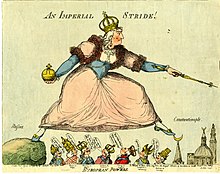
The attitude of the serfs toward their autocrat had historically been a positive one.
However, if the empress' policies were too extreme or too disliked, she
was not considered the true empress. In these cases, it was necessary to
replace this "fake" empress with the "true" empress, whoever she may
be. Because the serfs had no political power, they rioted to convey
their message. However, usually, if the serfs did not like the policies
of the empress, they saw the nobles as corrupt and evil, preventing the
people of Russia from communicating with the well-intentioned empress
and misinterpreting her decrees.
However, they were already suspicious of Catherine upon her accession
because she had annulled an act by Peter III that essentially freed the
serfs belonging to the Orthodox Church.
Naturally, the serfs did not like it when Catherine tried to take away
their right to petition her because they felt as though she had severed
their connection to the autocrat, and their power to appeal to her. Far
away from the capital, they were confused as to the circumstances of her
accession to the throne.
The peasants were discontented because of many other factors as well, including crop failure, and epidemics, especially a major epidemic in 1771.
The nobles were imposing a stricter rule than ever, reducing the land
of each serf and restricting their freedoms further beginning around
1767. Their discontent led to widespread outbreaks of violence and rioting during Pugachev's Rebellion
of 1774. The serfs probably followed someone who was pretending to be
the true empress because of their feelings of disconnection to Catherine
and her policies empowering the nobles, but this was not the first time
they followed a pretender under Catherine's reign.
Pugachev had made stories about himself acting as a real emperor
should, helping the common people, listening to their problems, praying
for them, and generally acting saintly, and this helped rally the
peasants and serfs, with their very conservative values, to his cause.
With all this discontent in mind, Catherine did rule for 10 years
before the anger of the serfs boiled over into a rebellion as extensive
as Pugachev's. The rebellion ultimately failed and in fact backfired as
Catherine was pushed away from the idea of serf liberation following the
violent uprising. Under Catherine's rule, despite her enlightened
ideals, the serfs were generally unhappy and discontented.
Arts and culture
Catherine was a patron of the arts, literature, and education. The Hermitage Museum, which now
occupies the whole Winter Palace, began as Catherine's personal
collection. The empress was a great lover of art and books, and ordered
the construction of the Hermitage in 1770 to house her expanding
collection of paintings, sculpture, and books.
By 1790, the Hermitage was home to 38,000 books, 10,000 gems and 10,000
drawings. Two wings were devoted to her collections of "curiosities". She ordered the planting of the first "English garden" at Tsarskoye Selo in May 1770. In a letter to Voltaire
in 1772, she wrote: "Right now I adore English gardens, curves, gentle
slopes, ponds in the form of lakes, archipelagos on dry land, and I have
a profound scorn for straight lines, symmetric avenues. I hate
fountains that torture water in order to make it take a course contrary
to its nature: Statues are relegated to galleries, vestibules etc.; in a
word, Anglomania is the master of my plantomania".
The throne of Empress Catherine II in the Winter Palace
Catherine shared in the general European craze for all things
Chinese, and made a point of collecting Chinese art and buying porcelain
in the popular Chinoiserie style. Between 1762 and 1766, she had built the "Chinese Palace" at Oranienbaum which reflected the chinoiserie style of architecture and gardening. The Chinese Palace was designed by the Italian architect Antonio Rinaldi who specialised in the chinoiserie style. In 1779, she hired the Scottish architect Charles Cameron to build the Chinese Village at Tsarskoye Selo (modern Pushkin, Saint Petersburg).
Catherine had at first attempted to hire a Chinese architect to build
the Chinese Village, and on finding that was impossible, settled on
Cameron, who likewise specialised in the chinoiserie style.
She made a special effort to bring leading intellectuals and
scientists to Russia, and she wrote her own comedies, works of fiction,
and memoirs. She worked with Voltaire, Diderot, and d'Alembert – all French encyclopedists who later cemented her reputation in their writings. The leading economists of her day, such as Arthur Young and Jacques Necker, became foreign members of the Free Economic Society, established on her suggestion in Saint Petersburg in 1765. She recruited the scientists Leonhard Euler and Peter Simon Pallas from Berlin and Anders Johan Lexell from Sweden to the Russian capital.
Catherine enlisted Voltaire to her cause, and corresponded with
him for 15 years, from her accession to his death in 1778. He lauded her
accomplishments, calling her "The Star of the North" and the "Semiramis of Russia" (in reference to the legendary Queen of Babylon,
a subject on which he published a tragedy in 1768). Although she never
met him face to face, she mourned him bitterly when he died. She
acquired his collection of books from his heirs, and placed them in the National Library of Russia.
Catherine read three sorts of books, namely those for pleasure, those
for information, and those to provide her with a philosophy.
In the first category, she read romances and comedies that were popular
at the time, many of which were regarded as "inconsequential" by the
critics both then and since. She especially liked the work of German comic writers such as Moritz August von Thümmel and Christoph Friedrich Nicolai. In the second category fell the work of Denis Diderot, Jacques Necker, Johann Bernhard Basedow and Georges-Louis Leclerc, Comte de Buffon.
Catherine expressed some frustration with the economists she read for
what she regarded as their impractical theories, writing in the margin
of one of Necker's books that if it was possible to solve all of the
state's economic problems in one day, she would have done so a long time
ago. For information about particular nations that interested her, she read Jean Baptiste Bourguignon d'Anville's Memoirs de Chine to learn about the vast and wealthy Chinese empire that bordered her empire; François Baron de Tott's Memoires de les Turcs et les Tartares for information about the Ottoman Empire and the Crimean khanate; the books of Frederick the Great praising himself to learn about Frederick just as much as to learn about Prussia; and the pamphlets of Benjamin Franklin denouncing the British Crown to understand the reasons behind the American Revolution. In the third category fell the work of Voltaire, Friedrich Melchior, Baron von Grimm, Ferdinando Galiani, Nicolas Baudeau, and Sir William Blackstone.
For philosophy, she liked books promoting what has been called
"enlightened despotism", which she embraced as her ideal of an
autocratic but reformist government that operated according to the rule
of law, not the whims of the ruler, hence her interest in Blackstone's
legal commentaries.
Within a few months of her accession in 1762, having heard the
French government threatened to stop the publication of the famous
French Encyclopédie on account of its irreligious spirit, Catherine proposed to Diderot
that he should complete his great work in Russia under her protection.
Four years later, in 1766, she endeavoured to embody in legislation the
principles of Enlightenment she learned from studying the French
philosophers. She called together at Moscow a Grand Commission – almost a
consultative parliament – composed of 652 members of all classes
(officials, nobles, burghers,
and peasants) and of various nationalities. The commission had to
consider the needs of the Russian Empire and the means of satisfying
them. The empress prepared the "Instructions for the Guidance of the Assembly", pillaging (as she frankly admitted) the philosophers of Western Europe, especially Montesquieu and Cesare Beccaria.
As many of the democratic principles frightened her more moderate and
experienced advisors, she refrained from immediately putting them into
practice. After holding more than 200 sittings, the so-called Commission
dissolved without getting beyond the realm of theory.
Catherine began issuing codes to address some of the
modernisation trends suggested in her Nakaz. In 1775, the empress
decreed a Statute for the Administration of the Provinces of the Russian
Empire. The statute sought to efficiently govern Russia by increasing
population and dividing the country into provinces and districts. By the
end of her reign, 50 provinces and nearly 500 districts were created,
government officials numbering more than double this were appointed, and
spending on local government increased sixfold. In 1785, Catherine
conferred on the nobility the Charter to the Nobility,
increasing the power of the landed oligarchs. Nobles in each district
elected a Marshal of the Nobility, who spoke on their behalf to the
monarch on issues of concern to them, mainly economic ones. In the same
year, Catherine issued the Charter of the Towns, which distributed all
people into six groups as a way to limit the power of nobles and create a
middle estate. Catherine also issued the Code of Commercial Navigation
and Salt Trade Code of 1781, the Police Ordinance of 1782, and the
Statute of National Education of 1786. In 1777, the empress described to
Voltaire her legal innovations within a backward Russia as progressing
"little by little".
The Bolshoi Theatre in the early 19th century
During Catherine's reign, Russians imported and studied the classical and European influences that inspired the Russian Enlightenment. Gavrila Derzhavin, Denis Fonvizin and Ippolit Bogdanovich laid the groundwork for the great writers of the 19th century, especially for Alexander Pushkin. Catherine became a great patron of Russian opera. Alexander Radishchev published his Journey from St. Petersburg to Moscow
in 1790, shortly after the start of the French Revolution. He warned of
uprisings in Russia because of the deplorable social conditions of the
serfs. Catherine decided it promoted the dangerous poison of the French
Revolution. She had the book burned and the author exiled to Siberia.
Catherine also received Elisabeth Vigée Le Brun
at her Tsarskoye Selo residence in St Petersburg, by whom she was
painted shortly before her death. Madame Vigée Le Brun vividly describes
the empress in her memoirs:
the sight of this famous woman so impressed me that I
found it impossible to think of anything: I could only stare at her.
Firstly I was very surprised at her small stature; I had imagined her to
be very tall, as great as her fame. She was also very fat, but her face
was still beautiful, and she wore her white hair up, framing it
perfectly. Her genius seemed to rest on her forehead, which was both
high and wide. Her eyes were soft and sensitive, her nose quite Greek,
her colour high and her features expressive. She addressed me
immediately in a voice full of sweetness, if a little throaty: "I am
delighted to welcome you here, Madame, your reputation runs before you. I
am very fond of the arts, especially painting. I am no connoisseur, but
I am a great art lover."
Madame Vigée Le Brun also describes the empress at a gala:
The double doors opened and the Empress appeared. I have
said that she was quite small, and yet on the days when she made her
public appearances, with her head held high, her eagle-like stare and a
countenance accustomed to command, all this gave her such an air of
majesty that to me she might have been Queen of the World; she wore the
sashes of three orders, and her costume was both simple and regal; it
consisted of a muslin tunic embroidered with gold fastened by a diamond
belt, and the full sleeves were folded back in the Asiatic style. Over
this tunic she wore a red velvet dolman with very short sleeves. The
bonnet which held her white hair was not decorated with ribbons, but
with the most beautiful diamonds.
Education
Catherine held western European philosophies and culture close to her
heart, and she wanted to surround herself with like-minded people
within Russia.
She believed a 'new kind of person' could be created by inculcating
Russian children with European education. Catherine believed education
could change the hearts and minds of the Russian people and turn them
away from backwardness. This meant developing individuals both
intellectually and morally, providing them knowledge and skills, and
fostering a sense of civic responsibility. Her goal was to modernise
education across Russia.
Catherine appointed Ivan Betskoy as her advisor on educational matters.
Through him, she collected information from Russia and other countries
about educational institutions. She also established a commission
composed of T.N. Teplov, T. von Klingstedt, F.G. Dilthey, and the
historian G. Muller. She consulted British education pioneers,
particularly the Rev. Daniel Dumaresq and Dr John Brown.
In 1764, she sent for Dumaresq to come to Russia and then appointed him
to the educational commission. The commission studied the reform
projects previously installed by I.I. Shuvalov under Elizabeth and under
Peter III. They submitted recommendations for the establishment of a
general system of education for all Russian orthodox subjects from the
age of 5 to 18, excluding serfs.
However, no action was taken on any recommendations put forth by the
commission due to the calling of the Legislative Commission. In July
1765, Dumaresq wrote to Dr. John Brown about the commission's problems
and received a long reply containing very general and sweeping
suggestions for education and social reforms in Russia. Dr. Brown
argued, in a democratic country, education ought to be under the state's
control and based on an education code. He also placed great emphasis
on the "proper and effectual education of the female sex"; two years
prior, Catherine had commissioned Ivan Betskoy to draw up the General
Programme for the Education of Young People of Both Sexes.
This work emphasised the fostering of the creation of a 'new kind of
people' raised in isolation from the damaging influence of a backward
Russian environment.
The Establishment of the Moscow Foundling Home (Moscow Orphanage) was
the first attempt at achieving that goal. It was charged with admitting
destitute and extramarital children to educate them in any way the state
deemed fit. Because the Moscow Foundling Home was not established as a
state-funded institution, it represented an opportunity to experiment
with new educational theories. However, the Moscow Foundling Home was
unsuccessful, mainly due to extremely high mortality rates, which
prevented many of the children from living long enough to develop into
the enlightened subjects the state desired.
Not long after the Moscow Foundling Home, at the instigation of her
factotum, Ivan Betskoy, she wrote a manual for the education of young
children, drawing from the ideas of John Locke, and founded the famous Smolny Institute
in 1764, first of its kind in Russia. At first, the institute only
admitted young girls of the noble elite, but eventually it began to
admit girls of the petit-bourgeoisie as well.
The girls who attended the Smolny Institute, Smolyanki, were often
accused of being ignorant of anything that went on in the world outside
the walls of the Smolny buildings, within which they acquired a
proficiency in French, music, and dancing, along with a complete awe of
the monarch. Central to the institute's philosophy of pedagogy was
strict enforcement of discipline. Running and games were forbidden, and
the building was kept particularly cold because too much warmth was
believed to be harmful to the developing body, as was excessive play.
From 1768 to 1774, no progress was made in setting up a national school system.
However, Catherine continued to investigate the pedagogical principles
and practice of other countries and made many other educational reforms,
including an overhaul of the Cadet Corps in 1766. The Corps then began
to take children from a very young age and educate them until the age of
21, with a broadened curriculum that included the sciences, philosophy,
ethics, history, and international law. These reforms in the Cadet
Corps influenced the curricula of the Naval Cadet Corps and the
Engineering and Artillery Schools. Following the war and the defeat of
Pugachev, Catherine laid the obligation to establish schools at the guberniya
– a provincial subdivision of the Russian empire ruled by a governor –
on the Boards of Social Welfare set up with the participation of elected
representatives from the three free estates.
By 1782, Catherine arranged another advisory commission to review
the information she had gathered on the educational systems of many
different countries. One system that particularly stood out was produced by a mathematician, Franz Aepinus.
He was strongly in favour of the adoption of the Austrian three-tier
model of trivial, real, and normal schools at the village, town, and
provincial capital levels.
In addition to the advisory commission, Catherine established a Commission of National Schools under Pyotr Zavadovsky.
This commission was charged with organising a national school network,
as well as providing teacher training and textbooks. On 5 August 1786,
the Russian Statute of National Education was created. The statute established a two-tier network of high schools and primary schools in guberniya
capitals that were free of charge, open to all of the free classes (not
serfs), and co-educational. It also stipulated in detail the subjects
to be taught at every age and the method of teaching. In addition to the
textbooks translated by the commission, teachers were provided with the
"Guide to Teachers". This work, divided into four parts, dealt with
teaching methods, subject matter, teacher conduct, and school
administration.
Despite these efforts, later historians of the 19th century were
generally critical. Some claimed Catherine failed to supply enough money
to support her educational program.
Two years after the implementation of Catherine's program, a member of
the National Commission inspected the institutions established.
Throughout Russia, the inspectors encountered a patchy response. While
the nobility provided appreciable amounts of money for these
institutions, they preferred to send their own children to private,
prestigious institutions. Also, the townspeople tended to turn against
the junior schools and their pedagogical
methods. Yet by the end of Catherine's reign, an estimated 62,000
pupils were being educated in some 549 state institutions. While a
significant improvement, it was only a minuscule number, compared to the
size of the Russian population.
Religious affairs
Catherine II in the Russian national costume
Catherine's apparent embrace of all things Russian (including
Orthodoxy) may have prompted her personal indifference to religion. She
nationalised all of the church lands to help pay for her wars, largely
emptied the monasteries, and forced most of the remaining clergymen to
survive as farmers or from fees for baptisms and other services. Very
few members of the nobility entered the church, which became even less
important than it had been. She did not allow dissenters to build
chapels, and she suppressed religious dissent after the onset of the
French Revolution.
However, in accord with her anti-Ottoman policy, Catherine
promoted the protection and fostering of Christians under Turkish rule.
She placed strictures on Catholics (ukaz
of 23 February 1769), mainly Polish, and attempted to assert and extend
state control over them in the wake of the partitions of Poland. Nevertheless, Catherine's Russia provided an asylum and a base for regrouping to the Jesuits following the suppression of the Jesuits in most of Europe in 1773.
Islam
Bashkir riders from the Ural steppes
Catherine took many different approaches to Islam during her reign.
She avoided force and tried persuasion (and money) to integrate Muslim
areas into her empire.
Between 1762 and 1773, Muslims were prohibited from owning any Orthodox
serfs. They were pressured into Orthodoxy through monetary incentives.
Catherine promised more serfs of all religions, as well as amnesty for
convicts, if Muslims chose to convert to Orthodoxy. However, the
Legislative Commission of 1767 offered several seats to people
professing the Islamic faith. This commission promised to protect their
religious rights, but did not do so. Many Orthodox peasants felt
threatened by the sudden change, and burned mosques as a sign of their
displeasure.
Catherine chose to assimilate Islam into the state rather than
eliminate it when public outcry became too disruptive. After the
"Toleration of All Faiths" Edict of 1773, Muslims were permitted to
build mosques and practise all of their traditions, the most obvious of these being the pilgrimage to Mecca, which previously had been denied. Catherine created the Orenburg Muslim Spiritual Assembly
to help regulate Muslim-populated regions as well as regulate the
instruction and ideals of mullahs. The positions on the Assembly were
appointed and paid for by Catherine and her government as a way of
regulating religious affairs.
In 1785, Catherine approved the subsidising of new mosques and new
town settlements for Muslims. This was another attempt to organise and
passively control the outer fringes of her country. By building new
settlements with mosques placed in them, Catherine attempted to ground
many of the nomadic people who wandered through southern Russia. In
1786, she assimilated the Islamic schools into the Russian public school
system under government regulation. The plan was another attempt to
force nomadic people to settle. This allowed the Russian government to
control more people, especially those who previously had not fallen
under the jurisdiction of Russian law.
Judaism
Russia often treated Judaism as a separate entity, where Jews were
maintained with a separate legal and bureaucratic system. Although the
government knew that Judaism existed, Catherine and her advisers had no
real definition of what a Jew is because the term meant many things
during her reign. Judaism was a small, if not non-existent, religion in Russia until 1772. When Catherine agreed to the First Partition of Poland,
the large new Jewish element was treated as a separate people, defined
by their religion. Catherine separated the Jews from Orthodox society,
restricting them to the Pale of Settlement.
She levied additional taxes on the followers of Judaism; if a family
converted to the Orthodox faith, that additional tax was lifted.
Jewish members of society were required to pay double the tax of their
Orthodox neighbours. Converted Jews could gain permission to enter the
merchant class and farm as free peasants under Russian rule.
In an attempt to assimilate the Jews into Russia's economy,
Catherine included them under the rights and laws of the Charter of the
Towns of 1782.
Orthodox Russians disliked the inclusion of Judaism, mainly for
economic reasons. Catherine tried to keep the Jews away from certain
economic spheres, even under the guise of equality; in 1790, she banned
Jewish citizens from Moscow's middle class.
In 1785, Catherine declared Jews to be officially foreigners, with foreigners' rights. This re-established the separate identity that Judaism maintained in Russia throughout the Jewish Haskalah.
Catherine's decree also denied Jews the rights of an Orthodox or
naturalised citizen of Russia. Taxes doubled again for those of Jewish
descent in 1794, and Catherine officially declared that Jews bore no
relation to Russians.
Russian Orthodoxy
St. Catherine Cathedral in
Kingisepp, an example of Late Baroque architecture
In many ways, the Orthodox Church fared no better than its foreign
counterparts during the reign of Catherine. Under her leadership, she
completed what Peter III had started. The church's lands were
expropriated, and the budget of both monasteries and bishoprics were
controlled by the Collegium of Accounting.
Endowments from the government replaced income from privately held
lands. The endowments were often much less than the original intended
amount.
She closed 569 of 954 monasteries, of which only 161 received
government money. Only 400,000 roubles of church wealth were paid back.
While other religions (such as Islam) received invitations to the
Legislative Commission, the Orthodox clergy did not receive a single
seat. Their place in government was restricted severely during the years of Catherine's reign.
In 1762, to help mend the rift between the Orthodox church and a sect that called themselves the Old Believers, Catherine passed an act that allowed Old Believers to practise their faith openly without interference.
While claiming religious tolerance, she intended to recall the Old
Believers into the official church. They refused to comply, and in 1764,
she deported over 20,000 Old Believers to Siberia on the grounds of
their faith.
In later years, Catherine amended her thoughts. Old Believers were
allowed to hold elected municipal positions after the Urban Charter of
1785, and she promised religious freedom to those who wished to settle
in Russia.
Religious education was reviewed strictly. At first, she
attempted to revise clerical studies, proposing a reform of religious
schools. This reform never progressed beyond the planning stages. By
1786, Catherine excluded all religion and clerical studies programs from
lay education.
By separating the public interests from those of the church, Catherine
began a secularisation of the day-to-day workings of Russia. She
transformed the clergy from a group that wielded great power over the
Russian government and its people to a segregated community forced to
depend on the state for compensation.
Personal life
Catherine, throughout her long reign, took many lovers, often
elevating them to high positions for as long as they held her interest
and then pensioning them off with gifts of serfs and large estates.
The percentage of state money spent on the court increased from 10% in
1767 to 11% in 1781 to 14% in 1795. Catherine gave away 66,000 serfs
from 1762 to 1772, 202,000 from 1773 to 1793, and 100,000 in one day: 18
August 1795.
Catherine bought the support of the bureaucracy. In 1767, Catherine
decreed that after seven years in one rank, civil servants automatically
would be promoted regardless of office or merit.
After her affair with her lover and adviser Grigory Potemkin
ended in 1776, he allegedly selected a candidate-lover for her who had
the physical beauty and mental faculties to hold her interest (such as Alexander Dmitriev-Mamonov and Nicholas Alexander Suk).
Some of these men loved her in return, and she always showed generosity
towards them, even after the affair ended. One of her lovers, Pyotr Zavadovsky, received 50,000 rubles, a pension of 5,000 rubles, and 4,000 peasants in Ukraine after she dismissed him in 1777. The last of her lovers, Platon Zubov, was 40 years her junior. Her sexual independence led to many of the legends about her.
Catherine kept her illegitimate son by Grigory Orlov (Alexis Bobrinsky, later elevated to Count Bobrinsky by Paul I) near Tula, away from her court.
Elite acceptance of a female ruler was more of an issue in Western Europe than in Russia. The British ambassador James Harris, 1st Earl of Malmesbury, reported back to London:
Her Majesty has a masculine force
of mind, obstinacy in adhering to a plan, and intrepidity in the
execution of it; but she wants the more manly virtues of deliberation,
forbearance in prosperity and accuracy of judgment, while she possesses
in a high degree the weaknesses vulgarly attributed to her sex—love of
flattery, and its inseparable companion, vanity; an inattention to
unpleasant but salutary advice; and a propensity to voluptuousness which
leads to excesses that would debase a female character in any sphere of
life.
Poniatowski
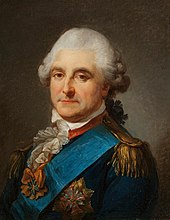
Sir Charles Hanbury Williams,
the British ambassador to Russia, offered Stanislaus Poniatowski a
place in the embassy in return for gaining Catherine as an ally.
Poniatowski, through his mother's side, came from the Czartoryski family,
prominent members of the pro-Russian faction in Poland; Poniatowski and
Catherine were eighth cousins, twice removed, by their mutual ancestor
King Christian I of Denmark, by virtue of Poniatowski's maternal descent from the Scottish House of Stuart.
Catherine, 26 years old and already married to the then-Grand Duke
Peter for some 10 years, met the 22-year-old Poniatowski in 1755,
therefore well before encountering the Orlov brothers. In 1757,
Poniatowski served in the British Army during the Seven Years' War, thus
severing close relationships with Catherine.[citation needed] She bore him a daughter named Anna Petrovna in December 1757 (not to be confused with Grand Duchess Anna Petrovna of Russia, the daughter of Peter I's second marriage), although she was legally regarded as Grand Duke Peter's.
King Augustus III of Poland
died in 1763, so Poland needed to elect a new ruler. Catherine
supported Poniatowski as a candidate to become the next king. She sent
the Russian army into Poland to avoid possible disputes. Russia invaded
Poland on 26 August 1764, threatening to fight, and imposing Poniatowski
as king. Poniatowski accepted the throne, and thereby put himself under
Catherine's control. News of Catherine's plan spread, and Frederick II
(others say the Ottoman sultan) warned her that if she tried to conquer
Poland by marrying Poniatowski, all of Europe would oppose her. She had
no intention of marrying him, having already given birth to Orlov's
child and to the Grand Duke Paul by then.
Prussia (through the agency of Prince Henry), Russia (under Catherine), and Austria (under Maria Theresa) began preparing the ground for the partitions of Poland. In the first partition, 1772, the three powers split 52,000 km2 (20,000 sq mi) among them. Russia got territories east of the line connecting, more or less, Riga–Polotsk–Mogilev. In the second partition, in 1793, Russia received the most land, from west of Minsk almost to Kiev and down the river Dnieper, leaving some spaces of steppe down south in front of Ochakov, on the Black Sea. Later uprisings in Poland led to the third partition in 1795. Poland ceased to exist as an independent nation until its post-WWI reconstitution.
Orlov
Grigory Orlov, the grandson of a rebel in the Streltsy Uprising (1698) against Peter the Great, distinguished himself in the Battle of Zorndorf
(25 August 1758), receiving three wounds. He represented an opposite to
Peter's pro-Prussian sentiment, with which Catherine disagreed. By
1759, he and Catherine had become lovers; no one told Catherine's
husband, the Grand Duke Peter. Catherine saw Orlov as very useful, and
he became instrumental in the 28 June 1762 coup d'état against her husband, but she preferred to remain the dowager empress of Russia rather than marrying anyone.
Grigory Orlov and his other three brothers found themselves
rewarded with titles, money, swords, and other gifts, but Catherine did
not marry Grigory, who proved inept at politics and useless when asked
for advice. He received a palace in Saint Petersburg when Catherine
became empress.
Orlov died in 1783. Their son, Aleksey Grygoriovich Bobrinsky
(1762–1813), had one daughter, Maria Alexeyeva Bobrinsky (Bobrinskaya)
(1798–1835), who married in 1819 the 34-year-old Prince Nikolai Sergeevich Gagarin (London, England, 1784–1842) who took part in the Battle of Borodino (7 September 1812) against Napoleon, and later served as ambassador in Turin, the capital of the Kingdom of Sardinia.
Potemkin
Grigory Potemkin was involved in the palace coup
of 1762. In 1772, Catherine's close friends informed her of Orlov's
affairs with other women, and she dismissed him. By the winter of 1773,
the Pugachev revolt
had started to threaten. Catherine's son Paul had started gaining
support; both of these trends threatened her power. She called Potemkin
for help – mostly military – and he became devoted to her.
In 1772, Catherine wrote to Potemkin. Days earlier, she had found
out about an uprising in the Volga region. She appointed General Aleksandr Bibikov
to put down the uprising, but she needed Potemkin's advice on military
strategy. Potemkin quickly gained positions and awards. Russian poets
wrote about his virtues, the court praised him, foreign ambassadors
fought for his favour, and his family moved into the palace. He later
became the de facto absolute ruler of New Russia, governing its
colonisation.
In 1780, Emperor Joseph II, the son of Holy Roman Empress Maria Theresa,
toyed with the idea of determining whether or not to enter an alliance
with Russia, and asked to meet Catherine. Potemkin had the task of
briefing him and travelling with him to Saint Petersburg. Potemkin also
convinced Catherine to expand the universities in Russia to increase the
number of scientists.
Catherine was worried that Potemkin's poor health would delay his
important work in colonising and developing the south as he had
planned. He died at the age of 52 in 1791.
Final months and death
Though Catherine's life and reign included remarkable personal
successes, they ended in two failures. Her Swedish cousin (once
removed), King Gustav IV Adolf,
visited her in September 1796, the empress's intention being that her
granddaughter Alexandra should become queen of Sweden by marriage. A
ball was given at the imperial court on 11 September when the engagement
was supposed to be announced. Gustav Adolph felt pressured to accept
that Alexandra would not convert to Lutheranism,
and though he was delighted by the young lady, he refused to appear at
the ball and left for Stockholm. The frustration affected Catherine's
health. She recovered well enough to begin to plan a ceremony which
would establish her favourite grandson Alexander
as her heir, superseding her difficult son Paul, but she died before
the announcement could be made, just over two months after the
engagement ball.
On 16 November [O.S.
5 November] 1796, Catherine rose early in the morning and had her usual
morning coffee, soon settling down to work on papers; she told her
lady's maid, Maria Perekusikhina, that she had slept better than she had in a long time. Sometime after 9:00 she was found on the floor with her face purplish, her pulse weak, her breathing shallow and laboured. The court physician diagnosed a stroke and despite attempts to revive her she fell into a coma. She was given the last rites and died the following evening around 9:45. An autopsy confirmed a stroke as the cause of death.
Later, several rumours
circulated regarding the cause and manner of her death. The most famous
of these rumors is that she died after having sex with her horse. This
rumor was widely circulated by satirical British and French publications
at the time of her death. In his 1647 book Beschreibung der muscowitischen und persischen Reise (Description of the Muscovite and Persian journey), German scholar Adam Olearius Olearius's claims about a supposed Russian tendency towards bestiality
with horses was often repeated in anti-Russian literature throughout
the 17th and 18th centuries to illustrate the alleged barbarous "Asian"
nature of Russia. Given the frequency which this story was repeated
together with Catherine's love of her adopted homeland and her love of
horses, it is likely that these details were conflated into this rumor.
Catherine had been targeted for being unmarried.
Catherine's undated will, discovered in early 1792 among her
papers by her secretary Alexander Vasilievich Khrapovitsky, gave
specific instructions should she die: "Lay out my corpse dressed in
white, with a golden crown on my head, and on it inscribe my Christian
name. Mourning dress is to be worn for six months, and no longer: the
shorter the better." In the end, the empress was laid to rest with a gold crown on her head and clothed in a silver brocade
dress. On 25 November, the coffin, richly decorated in gold fabric, was
placed atop an elevated platform at the Grand Gallery's chamber of
mourning, designed and decorated by Antonio Rinaldi. According to Élisabeth Vigée Le Brun:
"The empress's body lay in state for six weeks in a large and
magnificently decorated room in the castle, which was kept lit day and
night. Catherine was stretched on a ceremonial bed surrounded by the
coats of arms of all the towns in Russia. Her face was left uncovered,
and her fair hand rested on the bed. All the ladies, some of whom took
turn to watch by the body, would go and kiss this hand, or at least
appear to." A description of the empress's funeral is written in Madame
Vigée Le Brun's memoirs.
Issue
| Name |
Lifespan |
Notes
|
| Miscarriage
|
20 December 1752
|
According to court gossip, this lost pregnancy was attributed to Sergei Saltykov.
|
| Miscarriage
|
30 June 1753
|
This second lost pregnancy was also attributed to Saltykov;
this time she was very ill for 13 days. Catherine later wrote in her
memoirs: "...They suspect that part of the afterbirth has not come away
... on the 13th day it came out by itself".
|
Paul (I) Petrovich
Emperor of Russia
|
1 October 1754 –
23 March 1801 (Age: 46)
|
Born at the Winter Palace, officially he was a son of Peter III but
in her memoirs, Catherine implies very strongly that Saltykov was the
biological father of the child. He married firstly Princess Wilhelmina Louisa of Hesse-Darmstadt in 1773 and had no issue. He married secondly, in 1776, Princess Sophie Dorothea of Württemberg and had issue, including the future Alexander I of Russia and Nicholas I of Russia. He succeeded as emperor of Russia in 1796 and was murdered at Saint Michael's Castle in 1801.
|
Anna Petrovna
Grand Duchess of Russia
|
9 December 1757 –
8 March 1759 (Age: 15 months)
|
Possibly the offspring of Catherine and Stanislaus Poniatowski, Anna was born at the Winter Palace between 10 and 11 o'clock; she was named by Empress Elizabeth after her deceased sister, against Catherine's wishes. On 17 December 1757, Anna was baptised and received the Great Cross of the Order of Saint Catherine.
Elizabeth served as godmother; she held Anna above the baptismal font
and brought Catherine, who did not witness any of the celebrations, and
Peter a gift of 60,000 rubles. Elizabeth took Anna and raised the baby herself, as she had done with Paul. In her memoirs, Catherine makes no mention of Anna's death on 8 March 1759, though she was inconsolable and entered a state of shock. Anna's funeral took place on 15 March, at Alexander Nevsky Lavra. After the funeral, Catherine never mentioned her dead daughter again.
|
Alexei Grigorievich Bobrinsky [ru]
Count Bobrinsky
|
11 April 1762 –
20 June 1813 (Age: 51)
|
Born at the Winter Palace, he was brought up at Bobriki;
his father was Grigory Grigoryevich Orlov. He married Baroness Anna
Dorothea von Ungern-Sternberg and had issue. Created Count Bobrinsky in
1796, he died in 1813.
|
| Elizabeth Grigorevna Temkina (alleged daughter)
|
13 July 1775 –
25 May 1854 (Age: 78)
|
Born many years after the death of Catherine's husband, brought up in the Samoilov household as Grigory Potemkin's
daughter, and never acknowledged by Catherine, it has been suggested
that Temkina was the illegitimate child of Catherine and Potemkin, but
this is now regarded as unlikely.
|
Title
The Manifesto of 1763 begins with Catherine's title:
We, Catherine the second, by the
Grace of God, Empress and Autocrat of all the Russians at Moscow, Kiev,
Vladimir, Novgorod, Tsarina of Kasan, Tsarina of Astrachan, Tsarina of
Siberia, Lady of Pleskow and Grand Duchess of Smolensko, Duchess of
Estonia and Livland, Carelial, Tver, Yugoria, Permia, Viatka and
Bulgaria and others; Lady and Grand Duchess of Novgorod in the
Netherland of Chernigov, Resan, Rostov, Yaroslav, Beloosrial, Udoria,
Obdoria, Condinia, and Ruler of the entire North region and Lady of the
Yurish, of the Cartalinian and Grusinian tsars and the Cabardinian land,
of the Cherkessian and Gorsian princes and the lady of the manor and
sovereign of many others.
Archives
Empress Catherine's correspondence with Frederick II Eugene, Duke of Württemberg, (the father of Catherine's daughter-in-law Maria Feodorovna)
written between 1768 and 1795, is preserved in the State Archive of
Stuttgart (Hauptstaatsarchiv Stuttgart) in Stuttgart, Germany.
In popular culture
- Empress Catherine appears as a character in Lord Byron's unfinished mock-heroic poem Don Juan.
- She was a subject in The Royal Diaries series in the book Catherine: The Great Journey, Russia, 1743–1745 by Kristiana Gregory.
- The Empress is parodied in Offenbach's operetta La Grande-Duchesse de Gérolstein (1867).
- Ernst Lubitsch's silent film Forbidden Paradise (1924) told the story of Catherine's romance with an officer.
- Marlene Dietrich portrayed Catherine the Great in the film The Scarlet Empress (1934).
- The Rise of Catherine the Great (1934) is a film starring Elisabeth Bergner and Douglas Fairbanks Jr.
- Lubitsch remade his 1924 silent film as the sound film A Royal Scandal (1945), also known as Czarina.
- Mae West published Catherine Was Great in 1944, starring in it then and in subsequent productions.
- Jeanne Moreau played a version of Catherine in the farce comedy film Great Catherine (1968).
- The British/Canadian/American TV miniseries Young Catherine (1991), starring Julia Ormond as Catherine and Vanessa Redgrave as Empress Elizabeth, is based on Catherine's early life.
- The television movie Catherine the Great (1995) stars Catherine Zeta-Jones as Catherine and Jeanne Moreau as Empress Elizabeth.
- Actress Olga Antonova played the role of the Empress in the 2000 film The Captain's Daughter, based on the novel of the same name by Alexander Pushkin.
- Her rise to power and reign are portrayed in the award-winning Russia-1 television series Ekaterina, which has been extended for a second season in 2017 and a third season in 2019.
- The Channel One Russia television series Catherine the Great was released in 2015.
- The song "Catherine the Great" from the album Foreverland by The Divine Comedy was released as a single on the 24th of June, 2016.
- Catherine (portrayed by Meghan Tonjes) is featured in the web series Epic Rap Battles of History, in the episode "Alexander the Great vs. Ivan the Terrible" (12 July 2016), pitted against the titular characters, as well as Frederick the Great and Pompey the Great.[156]
- The television miniseries Catherine the Great (2019) stars Helen Mirren.
- She is portrayed by Elle Fanning in the Hulu television series The Great (2020).
- She appears as a leader of the Russian civilization in Civilization games II, III, IV and V.
